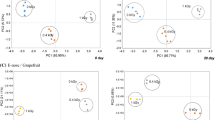Abstract
This study focuses on applicability of e-sensing methods in addition to direct epifluorescent filter technique (DEFT), aerobic plate counts (APC), and photostimulated luminescence (PSL) to discriminate e-beam, γ-ray, and X-ray irradiated green onions (scallions) at 1, 4, and 7 kGy for each irradiation treatment, along with two confirmatory analysis. Although low dose (1 kGy) reduced the APC (6.15–2.69 log CFU/g), no significant difference was observed in DEFT. Scallions with log DEFT/APC ratio of ≥ 5.2 can be suspected as irradiated at at least 1 kGy. Both non-irradiated (< 700 counts/min) and irradiated (> 5000 counts/min) scallions were identified by PSL. Besides distinct volatile compounds profile, cumulative e-nose discrimination of 92.06% from principle component analysis was apparent among irradiation conditions. Sensitivity to changes in perceived taste by e-tongue showed 96.07% variation. The e-sensing capability to discriminate irradiated scallions can be exploited for exposing counterfeit claims as either non-irradiated or irradiated within the recommended standards.




Similar content being viewed by others
References
Ahn JJ, Kim GR, Akram K, Kim KS, Kwon JH (2012) Effect of storage conditions on photostimulated luminescence of irradiated garlic and potatoes. Food Res Int 47:315–320
Akram K, Ahn JJ, Kim GR, Kwon JH (2012) Applicability of different analytical methods for the identification of γ-irradiated fresh mushrooms during storage. Food Sci Biotechnol 21:573–579
Alberti A, Corda U, Fuochi P, Bortolin E, Calicchia A, Onori S (2007) Lightinduced fading of the PSL signal from irradiated herbs and spices. Radiat Phys Chem 76:1455–1458
Bayram G, Delincèe H (2004) Identification of irradiated Turkish foodstuffs combining various physical detection methods. Food Control 15:81–91
Bortolin E, Boniglia C, Calicchia A, Alberti A, Fuochi P, Onori S (2007) Irradiated herbs and spices detection: light-induced fading of the photo-stimulated luminescence response. Int J Food Sci Technol 42:330–335
Di Natale C, Paolesse R, Burgio M, Martinelli E, Pennazza G, D’Amico A (2004) Application of metalloporphyrins-based gas and liquid sensor arrays to the analysis of red wine. Anal Chim Acta 513:49–56
EN 13751 (2002) Foodstuffs—Detection of irradiated food using photostimulated luminescence. European Committee for Standardization. https://ec.europa.eu/food/sites/food/files/safety/docs/biosafety-irradiation-legislation-13751-2002_en.pdf. Accessed 27 Sept 2018
EN 13783 (2001) Detection of irradiated food using Direct Epifluorescent Filter Technique/Aerobic Plate Count (DEFT/APC)—Screening method. European Committee for Standardization. https://ec.europa.eu/food/sites/food/files/safety/docs/biosafety-irradiation-legislation-13783-2001_en.pdf. Accessed 27 Sept 2018
EN 1787 (2000) Foodstuffs—Detection of irradiated food containing cellulose: Method by ESR spectroscopy. European Committee for Standardization. https://ec.europa.eu/food/sites/food/files/safety/docs/biosafety-irradiation-legislation-1787-2000_en.pdf. Accessed 27 Sept 2018
EN 1788 (2001) Foodstuffs—Thermoluminescence detection of irradiated food from which silicate minerals can be isolated. European Committee for Standardization. https://ec.europa.eu/food/sites/food/files/safety/docs/biosafety-irradiation-legislation-1788-2001_en.pdf. Accessed 27 Sept 2018
Guzik GP, Shukla AK (2017) ESR detection of irradiated food materials. In: Shukla AK (ed) Electron spin resonance in food science. Academic Press, London, pp 45–62
Kim JH, Ahn HJ, Yook HS, Kim KS, Rhee MS, Ryu GH, Byun MW (2004) Color, flavor, and sensory characteristics of gamma-irradiated salted and fermented anchovy sauce. Radiat Phys Chem 69:179–187
Lee JH, Lee KT, Kim MR (2005) Effect of gamma-irradiated red pepper powder on the chemical and volatile characteristics of Kakdugi, a Korean traditional fermented radish kimchi. J Food Sci 70:C441–C447
Nikolova R, Diakova A, Tzvetkova E, Aleksieva K, Dimov K, Yordanov ND (2007) Investigations on detection of irradiated fruits. Food Process Ind Mag Sofia 7:49–51
Oh KN, Lee SY, Lee HJ, Kim KE, Yang JS (2003) Screening of gamma irradiated spices in Korea by using a microbiological method (DEFT/APC). Food Control 14:489–494
Prata R, Pereira JA, Rodrigues N, Dias LG, Veloso AC, Casal S, Peres AM (2018) Olive oil total phenolic contents and sensory sensations trends during oven and microwave heating processes and their discrimination using an electronic tongue. J Food Qual 2018:1–10
Raffi J, Yordanov ND, Chabane S, Douifi L, Gancheva V, Ivanova S (2000) Identification of irradiation treatment of aromatic herbs, spices and fruits by electron paramag- netic resonance and thermoluminescence. Spectrochim Acta A 56:409–416
Ray AA (1982) SAS user’s guide: statistics. SAS Institute, Cary, pp 119–138
Rodrigues AS, Fogliano V, Graziani G, Mendes S, Vale AP, Gonçalves C (2003) Nutritional value of onion regional varieties in northwest Portugal. Electron J Environ Agric Food Chem 2:519–524
Schaller E, Bosset JO, Escher F (1998) Electronic noses and their application to food. LWT-Food Sci Technol 31:305–316
Sinesio F, Di Natale C, Quaglia GB, Bucarelli FM, Moneta E, Macagnano A, Paolesse R, D’Amico A (2000) Use of electronic nose and trained sensory panel in the evaluation of tomato quality. J Sci Food Agric 80:63–71
SPSS (2013) SPSS version 17 for windows user’s guide. SPSS, Chicago, pp 332–334
WHO (1988) Food irradiation. A technique for preserving and improving the safety of food. World Health Organization, Geneva, pp 80–84
Woertz K, Tissen C, Kleinebudde P, Breitkreutz J (2010) Performance qualification of an electronic tongue based on ICH guideline Q2. J Pharm Biomed Anal 51:497–506
Acknowledgements
This research was supported by the funding from National Research Foundation of Korea (NRF-2016R1D1A3B03931282, 2016).
Author information
Authors and Affiliations
Corresponding author
Additional information
Publisher's Note
Springer Nature remains neutral with regard to jurisdictional claims in published maps and institutional affiliations.
Rights and permissions
About this article
Cite this article
Chung, N., Ramakrishnan, S.R. & Kwon, JH. Experimental validation and evaluation of electronic sensing techniques for rapid discrimination of electron-beam, γ-ray, and X-ray irradiated dried green onions (Allium fistulosum). J Food Sci Technol 56, 5454–5464 (2019). https://doi.org/10.1007/s13197-019-04016-w
Revised:
Accepted:
Published:
Issue Date:
DOI: https://doi.org/10.1007/s13197-019-04016-w




